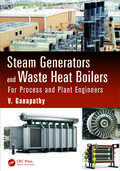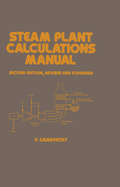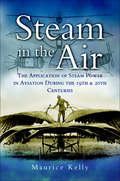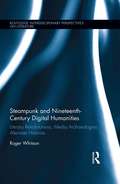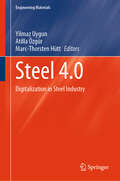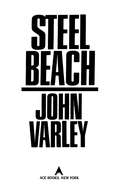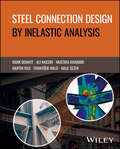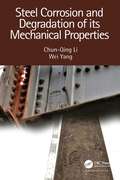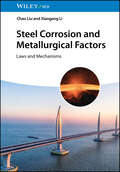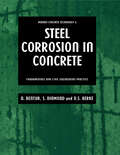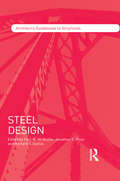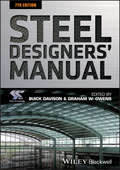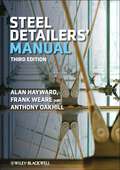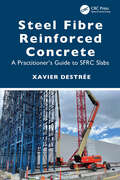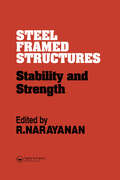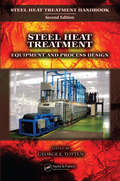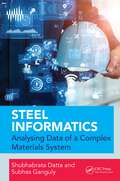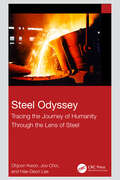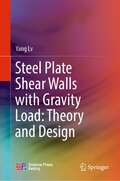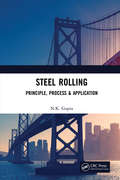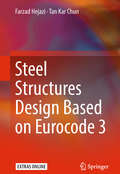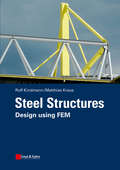- Table View
- List View
Steam Generators and Waste Heat Boilers: For Process and Plant Engineers (Mechanical Engineering)
by V. GanapathyIncorporates Worked-Out Real-World ProblemsSteam Generators and Waste Heat Boilers: For Process and Plant Engineers focuses on the thermal design and performance aspects of steam generators, HRSGs and fire tube, water tube waste heat boilers including air heaters, and condensing economizers. Over 120 real-life problems are fully worked out which wi
Steam Plant Calculations Manual, Revised and Expanded (Mechanical Engineering #87)
by GanapathyMaintaining a question-and-answer format, this second edition provides simplified means of solving nearly 200 practical problems that confront engineers involved in the planning, design, operation and maintenance of steam plant systems. Calculations pertaining to emissions, boiler efficiency, circulation and heat transfer equipment design and performance are provided. Solutions to 70 new problems are featured in this edition.
Steam in the Air: The Application of Steam Power in Aviation During the 19th & 20th Centuries
by Maurice KellyThis unique history of aviation offers a detailed look at early experimental aircraft designs created by pioneering engineers in the Age of Steam. In the early 19th century, when scientific investigation into manned flight began, it was only natural that intrepid inventors would turn to steam power to propel their machines—no other portable source of propulsion was available. Though largely unsuccessful, the resulting creations made significant breakthroughs in the early development of aeronautics and aviation. In Steam in the Air, aviation historian Maurice Kelly provides a detailed look at many of these intriguing, fanciful and extraordinary designs from around the world. With accessible prose and helpful illustrations, Kelly describes the various types of steam engines adapted for use in flight and the flying-machines into which they were fitted.
Steampunk and Nineteenth-Century Digital Humanities: Literary Retrofuturisms, Media Archaeologies, Alternate Histories (Routledge Interdisciplinary Perspectives on Literature)
by Roger WhitsonSteampunk is more than a fandom, a literary genre, or an aesthetic. It is a research methodology turning history inside out to search for alternatives to the progressive technological boosterism sold to us by Silicon Valley. This book turns to steampunk's quirky temporalities to embrace diverse genealogies of the digital humanities and to unite their methodologies with nineteenth-century literature and media archaeology. The result is nineteenth-century digital humanities, a retrofuturist approach in which readings of steampunk novels like William Gibson and Bruce Sterling's The Difference Engine and Ken Liu's The Grace of Kings collide with nineteenth-century technological histories like Charles Babbage's use of the difference engine to enhance worker productivity and Isabella Bird's spirit photography of alternate history China. Along the way, Steampunk and Nineteenth-Century Digital Humanities considers steampunk as a public form of digital humanities scholarship and activism, examining projects like Kinetic Steam Works's reconstruction of Henri Giffard's 1852 steam-powered airship, Jake von Slatt's use of James Wimshurst's 1880 designs to create an electric influence machine, and the queer steampunk activism of fans appearing at conventions around the globe. Steampunk as a digital humanities practice of repurposing reacts to the growing sense of multiple non-human temporalities mediating our human histories: microtemporal electricities flowing through our computer circuits, mechanical oscillations marking our work days, geological stratifications and cosmic drifts extending time into the millions and billions of years. Excavating the entangled, anachronistic layers of steampunk practice from video games like Bioshock Infinite to marine trash floating off the shore of Los Angeles and repurposed by media artist Claudio Garzón into steampunk submarines, Steampunk and Nineteenth-Century Digital Humanities uncovers the various technological temporalities and multicultural retrofutures illuminating many alternate histories of the digital humanities.
Steel 4.0: Digitalization in Steel Industry (Engineering Materials)
by Marc-Thorsten Hütt Yilmaz Uygun Atilla ÖzgürThis book addresses digitalization and the steel industry. It is written from the perspective of both industrial engineering and data science and discusses digitalization problems, novel production planning and scheduling algorithms in ironmaking and steelmaking, machine learning applications and opportunities in steel plants and quality-related algorithms in steel plants. Even though digitalization is an important trend in steel industry, current contributions mainly focus on lower automation levels, i.e., field and control levels, that are mainly covered in mechanical, electrical and material engineering domains. On higher planning levels, there are hardly comprehensive scientific contributions on intelligent digitalization issues available. This book fills this gap.
Steel Beach (Eight Worlds #2)
by John VarleyA science fiction epic from "the best writer in America" (Tom Clancy)--Hugo and Nebula award-winning author John Varley. Fleeing Earth after an alien invasion, the human race stands on the threshold of evolution. Their new home is Luna, a moon colony blessed with creature comforts, prolonged lifespans, digital memories, and instant sex changes.But the people of Luna are bored, restless, suicidal--and so is the computer that monitors their existence...
Steel Connection Analysis
by Paolo RugarliFirst book to discuss the analysis of structural steel connections by Finite Element Analysis—which provides fast, efficient, and flexible checking of these vital structural components The analysis of steel structures is complex—much more so than the analysis of similar concrete structures. There are no universally accepted rules for the analysis of connections in steel structures or the analysis of the stresses transferred from one connection to another. This book presents a general approach to steel connection analysis and check, which is the result of independent research that began more than fifteen years ago. It discusses the problems of connection analysis and describes a generally applicable methodology, based on Finite Element Analysis, for analyzing the connections in steel structures. That methodology has been implemented in software successfully, providing a fast, automatic, and flexible route to the design and analysis of the connections in steel structures. Steel Connection Analysis explains several general methods which have been researched and programmed during many years, and that can be used to tackle the problem of connection analysis in a very general way, with a limited and automated computational effort. It also covers several problems related to steel connection analysis automation. Uses Finite Element Analysis to discuss the analysis of structural steel connections Analysis is applicable to all connections in steel structures The methodology is the basis of the commercially successful CSE connection analysis software Analysis is fast and flexible Structural engineers, fabricators, software developing firms, university researchers, and advanced students of civil and structural engineering will all benefit from Steel Connection Analysis.
Steel Connection Design by Inelastic Analysis
by Mark D. Denavit Ali Nassiri Mustafa Mahamid Martin Vild Halil Sezen Frantisek Wald IDEA StatiCaComprehensive resource on the finite element method in structural steel connection design through verification with AISC 360 provisions Steel Connection Design by Inelastic Analysis covers the use of the finite element method in structural steel connection design. Verification with AISC 360 provisions is presented, focusing on the Component-Based Finite Element Method (CBFEM), a novel approach that provides the global behavior and verification of resistance for the design of structural steel connections. This method is essential for fast and practical design and evaluation of connections with different levels of geometry and complexity. Detailed modeling and verification examples with references to AISC and other relevant publications are included throughout the text, along with roughly 250 illustrations to aid in reader comprehension. Readers of this text will benefit from understanding at least the basics of structural design, ideally through civil, structural, or mechanical engineering programs of study. Written by a team of six highly qualified authors, Steel Connection Design by Inelastic Analysis includes information on: T-stub connections, single plate shear connections, bracket plate connections, beam over column connections, and end-plate moment connectionsBolted wide flange splice connections, temporary splice connections, and chevron brace connection in a braced frame Brace connections at beam-column connection in a braced frame and double angle simple beam-to-column connectionsSemi-rigid beam-to-column connections, covering code design calculations and comparisons, IDEA StatiCa analysis, and ABAQUS analysis Steel Connection Design by Inelastic Analysis is an authoritative reference on the subject for structural engineers, Engineers of Record (EORs), fabrications specialists, and connection designers involved in the structural design of steel connections in the United States or any territory using AISC 360 as the primary design code.
Steel Corrosion and Degradation of its Mechanical Properties
by Chun-Qing Li Wei YangThis book presents the state-of-the-art-knowledge on corrosion of steel, cast iron and ductile iron with a focus on corrosion-induced degradation of their mechanical properties. The information presented in the book is largely derived from the most current research on the effect of corrosion on degradation of mechanical properties. The book covers the basics of steel corrosion, including that of cast iron and ductile iron, that are not well covered in most literature. Models for corrosion-induced degradation of mechanical properties are presented in the book with a view to wider applications. The knowledge presented in the book can be used to prevent corrosion-induced failures of corrosion-affected structures, offering enormous benefits to the industry, business, society and community. Key strengths of the book are that it can be employed by a variety of users for different purposes in designing and assessing corrosion-affected structures, and that the knowledge and techniques presented in the book can be easily applied by users in dealing with corrosion-affected structures, and the uniqueness in examining the corrosion effect on degradation of various mechanical properties. Wtih examples of practical applications, the book is particularly useful for all stakeholders involved in steel manufacturing and construction, including engineering students, academicians, researchers, practitioners and asset managers.
Steel Corrosion and Metallurgical Factors: Laws and Mechanisms
by Chao Liu Xiaogang LiExploration into the latest research and developments in material corrosion resistance and related technologies Steel Corrosion and Metallurgical Factors: Laws and Mechanisms offers an in-depth exploration of the latest research on modulating metallurgical factors in various types of steel materials to enhance their corrosion resistance. The book covers a diverse range of materials, including low-alloy steels, stainless steels, ductile iron, rebar, and pipeline steel, and outlines the application of corrosion big data technology and artificial intelligence in the revealing of material corrosion mechanisms. The book discusses how typical metallurgical factors such as inclusion control, alloying control, and heat treatment control influence the corrosion resistance of stainless or low alloy steels and provides theoretical guidance for corrosion-resistant steel smelting technologies (e.g., inclusions regulation, alloy modulation, and rolling processes) by investigating the laws and mechanisms underlying the influence of various metallurgical factors on the corrosion resistance of steel. Steel Corrosion and Metallurgical Factors includes information on: Micro- chemical-electrochemical theory of corrosion initiation induced by various typical types of inclusions in stainless and low alloy steelsInfluence of elements such as Ca, Sb, Cu, and Cr on the resistance of low-alloy steels to microbial and marine atmospheric corrosionCoupled mechanism of microstructure and inclusions in corrosion initiation in steelBehavior and mechanism of stress corrosion and hydrogen-induced stress corrosion of pipeline steel induced by environmental and metallurgical factorsEffects of rare earth and chromium elements on the corrosion resistance of HRB400 rebar in concrete environmentsMetallurgical defects on ductile iron corrosion mechanisms and corrosion big data-artificial intelligence techniques in revealing factors influencing material corrosion Steel Corrosion and Metallurgical Factors strongly supports metallurgical and materials researchers and engineers in developing new corrosion-resistant steels.
Steel Corrosion in Concrete: Fundamentals and civil engineering practice (Modern Concrete Technology)
by Arnon Bentur Neal Berke Sidney DiamondPoor durability of concrete is a major cause of problems in modern building and civil engineering structures in all countries: the annual cost of investigating and repairing deteriorating reinforced concrete structures runs into many millions of pounds. This book explains the fundamentals of the corrosion of steel in concrete. It is comprehensive a
Steel Design (Architect's Guidebooks to Structures)
by Paul W. McMullin Jonathan S. Price Richard T. SeelosSteel Design covers steel design fundamentals for architects and engineers, such as tension elements, flexural elements, shear and torsion, compression elements, connections, and lateral design. As part of the Architect’s Guidebooks to Structures series it provides a comprehensive overview using both imperial and metric units of measurement. Each chapter includes design steps, rules of thumb, and design examples. This book is meant for both professionals and for students taking structures courses or comprehensive studies. As a compact summary of key ideas, it is ideal for anyone needing a quick guide to steel design. More than 150 black and white images are included.
Steel Designers' Manual
by Graham W. Owens Buick Davison SCIIn 2010 the then current European national standards for building and construction were replaced by the EN Eurocodes, a set of pan-European model building codes developed by the European Committee for Standardization. The Eurocodes are a series of 10 European Standards (EN 1990 - EN 1999) that provide a common approach for the design of buildings, other civil engineering works and construction products. The design standards embodied in these Eurocodes will be used for all European public works and are set to become the de-facto standard for the private sector in Europe, with probable adoption in many other countries.This classic manual on structural steelwork design was first published in 1955, since when it has sold many tens of thousands of copies worldwide. For the seventh edition of the Steel Designers' Manual all chapters have been comprehensively reviewed, revised to ensure they reflect current approaches and best practice, and brought in to compliance with EN 1993: Design of Steel Structures (the so-called Eurocode 3).
Steel Detailers' Manual
by Alan Hayward Frank Weare A. C. OakhillThis highly illustrated manual provides practical guidance on structural steelwork detailing. It: · describes the common structural shapes in use and how they are joined to form members and complete structures · explains detailing practice and conventions · provides detailing data for standard sections, bolts and welds · emphasises the importance of tolerances in order to achieve proper site fit-up · discusses the important link between good detailing and construction costs Examples of structures include single and multi-storey buildings, towers and bridges. The detailing shown will be suitable in principle for fabrication and erection in many countries, and the sizes shown will act as a guide to preliminary design. The third edition has been revised to take account of the new Eurocodes on structural steel work, together with their National Annexes. The new edition also takes account of developments in 3-D modelling techniques and it includes more CAD standard library details.
Steel Fibre Reinforced Concrete: A Practitioner’s Guide to SFRC Slabs
by Xavier DestréeSteel fiber reinforced concrete (SFRC) for structures dates back to 1925, yet it remains largely unknown to many engineers and contractors. Essential information is often buried in codes, reports, and standards. This book presents the essential information required by engineers to utilize SFRC effectively, achieving superior results across a range of applications.The focus is on its most common use in flat, horizontal cast in situ applications, such as ground-bearing slabs, ground-suspended slabs, suspended elevated slabs, and raft slab foundations for buildings, which present more opportunities than three-dimensional structures. Prefabrication and paving are discussed where they intersect with these main applications. Material and structural testing are addressed to guide the design for these typical applications, with attention also given to shrinkage, cracking, fire resistance of slabs and walls, and environmental benefits, alongside future opportunities and challenges. This unique book provides simple practical guidance for designing and placing SFRC It is especially helpful for design-and-build contractors and professional engineers It offers simple tools and methods to launch a project
Steel Framed Structures: Stability and strength
by R. NarayananSteel Framed Structures contains ten chapters on rigid frames, sway frames, multi-storey frames, interbraced columns and beams, elastic stability, moment-resisting connections, flexibly connected frames, portal frames, and braced arches.
Steel Heat Treatment: Equipment and Process Design
by George E. TottenOne of two self-contained volumes belonging to the newly revised Steel Heat Treatment Handbook, Second Edition, this book focuses on process design, equipment, and testing used in steel heat treatment. Steel Heat Treatment: Equipment and Process Design presents the classical perspectives that form the basis of heat treatment processes while
Steel Heat Treatment: Metallurgy and Technologies (Steel Heat Treatment Handbook, Second Edition)
by George E. TottenOne of two self-contained volumes belonging to the newly revised Steel Heat Treatment Handbook, Second Edition, this book examines the behavior and processes involved in modern steel heat treatment applications.Steel Heat Treatment: Metallurgy and Technologies presents the principles that form the basis of heat treatment processes while inc
Steel Informatics: Analysing Data of a Complex Materials System
by Shubhabrata Datta Subhas GangulySteel Informatics aims to review the application of data-driven computing techniques related to the design of steel, including phase transformation, composition-process-property correlation, and different processing techniques, particularly deformation and joining. This book initiates with fundamentals of informatics followed by a description of applications of statistical analyses in defining the different attributes of steel. The proceeding chapters of this book cover recent applications of statistical, machine learning, expert systems, and optimization algorithms in the domains of iron and steel making, casting, deformation, phase transformation and heat treatment, microstructure analysis, and design of steel.Features:• Exclusive title focussing on informatics in steel design.• Covers related statistics as well as artificial intelligence and machine learning aspects.• Explains metallurgical aspects lucidly for the data scientists, steel researchers, and industries.• Discusses all aspects of steel technology.• Describes pertinent tools used for related computations.This book is useful for researchers, professionals, and graduate students in metallurgy, materials science, steel and welding, and computational materials science.
Steel Odyssey: Tracing the Journey of Humanity Through the Lens of Steel
by Ohjoon KWON JOO Choi Hae-Geon LEEIn this wide-ranging interdisciplinary work, the authors draw on history, anthropology, and materials engineering to present a comprehensive and ambitious examination of the multifaceted roles of iron and steel throughout history and the current and future challenges faced by the steel industry.Ohjoon Kwon, Joo Choi, and Hae-Geon Lee provide readers with an in-depth understanding of the history of iron and steel and their impact on human society from a materials engineering perspective. They begin by describing the characteristics of iron and steel and the history of human use of and interaction with these metals by compiling the fundamental knowledge necessary to understand iron’s unique properties and metallurgical phenomena. Following this, they explain the influence of steel on human society and culture, focusing on Industrial Revolution and warfare. They also give examples that are rarely discussed elsewhere, such as developments in Asia or iron’s influence on thought and philosophy using Confucianism and Marxism as examples. Readers will then be able to apply this contextual knowledge to address the profound impact of emerging challenges, such as global environmental issues and the Fourth Industrial Revolution.Despite the technical nature of this book, all terminology is fully explained to facilitate better comprehension for those who may not possess an engineering education or a direct interest in metallurgy. This book is therefore invaluable not only as a technical book but also as a guide to the development history of human civilization and its future challenges.
Steel Plate Shear Walls with Gravity Load: Theory and Design
by Yang LvThis book is written by subject experts based on the recent research results in steel plate shear walls considering the gravity load effect. It establishes a vertical stress distribution of the walls under compression and in-plane bending load and an inclination angle of the tensile field strip. The stress throughout the inclined tensile strip, as we consider the effect of the vertical stress distribution, is determined using the von Mises yield criterion. The shear strength is calculated by integrating the shear stress along the width. The proposed theoretical model is verified by tests and numerical simulations. Researchers, scientists and engineers in the field of structural engineering can benefit from the book. As such, this book provides valuable knowledge, useful methods, and practical algorithms that can be considered in practical design of building structures adopting a steel shear wall system.
Steel Rolling: Principle, Process & Application
by N.K. GuptaThis book covers all aspects and elements of rolling technology in one volume with even the most technical jargon being communicated in an easy to understand language. The book is exhaustive as topics ranging from rolls, rolls cooling, roll turning, roll reclamation, investigation of roll breakage, roll management and roll bearing all have been dealt in detail as these constitute the most important element of production cost. A separate chapter has been dedicated to operational management of a rolling mill, which includes safety and inventory. Packaging of the finished products and modern operating mill practices and technologies are also discussed in detail. This book will be a useful tool for shop floor personnel and for all senior management operating in the rolling mill industry; it is also a must read for all polytechnic / engineering students of metallurgical / mechanical / process engineering.This book may also be useful as reference book for students/professionals of rolling technology. Note: T&F does not sell or distribute the Hardback in India, Pakistan, Nepal, Bhutan, Bangladesh and Sri Lanka.
Steel Structures Design Based on Eurocode 3
by Farzad Hejazi Tan Kar ChunThis book is tailored to the needs of structural engineers who are seeking to become familiar with the design of steel structures based on Eurocode 3. It explains each step of the design process using comprehensive flow charts, tables and equations as well as numerous examples. The useful appendices, including general sections and properties as well as general formulas for shear force, maximum bending moment and deflection for several selected loading conditions, offer designers a valuable source of reference. The book also introduces a specially developed design-aid program, which provides immediate results without the need for modeling, and as such considerably reduces the time needed for the design stage.
Steel Structures: Design using FEM
by Rolf Kindmann Matthias KrausThis book presents the design of steel structures using finite element methods (FEM) according to the current state of the art in Germany and the rest of Europe. After a short introduction on the basics of the design, this book illustrates the FEM with a focus on internal forces, displacements, critical loads and modal shapes. Next to finite element procedures for linear calculations considering the stress states of normal force, biaxial bending and warping torsion, non-linear calculations and the stability cases of flexural buckling, lateral torsional buckling and plate buckling are concentrated on significantly. In this context, design procedures for stability according to the standard Eurocode 3 is introduced and discussed. In addition, important fundamental issues are covered, such as the determination of cross-section properties as well as the elastic and plastic cross-section resistance. Complementary, finite element procedures for cross sections are dealt with, which will have an increasing importance in future. This book has evolved within the teaching activities of the authors in the lecture Computer-oriented Design of Steel Structures on the Master?s Program Computational Engineering at the University of Bochum. It covers the total variety of demands needed to be discussed for the safe, economic and modern design of steel structures.
Steel Surfaces: A Guide to Alloys, Finishes, Fabrication, and Maintenance in Architecture and Art (Architectural Metals Series)
by L. William ZahnerA full-color guide for architects and design professionals to the selection and application of steel Steel Surfaces, fourth in Zahner’s Architectural Metals Series, provides a comprehensive and authoritative treatment of steel applications in architecture and art. It offers architecture and design professionals the information they need to ensure proper maintenance and fabrication techniques through detailed information and full-color images. It covers everything from the history of the metal and choosing the right alloy, to detailed information on a variety of surface and chemical finishes and corrosion resistance. The book also features case studies that offer strategies for designing and executing successful projects using steel. Steel Surfaces is filled with illustrated case studies that present comprehensive coverage of how steel is used in creating surfaces for building exteriors, interiors, and art finishes. All the books in Zahner’s Architectural Metals Series offer in-depth coverage of today’s most commonly used metals in architecture and art. This visual guide: Features full-color images of a variety of steel finishes, colors, textures, and forms Includes case studies with performance data that feature strategies on how to design and execute successful projects using steel Offers methods to address corrosion, before and after it occurs Explains the significance of the different alloys and the forms available to the designer Discusses what to expect when using steel in various exposures Written for architecture professionals, metal fabricators and developers, architecture students, designers, and artists working with metals, Steel Surfaces offers a logical framework for the selection and application of steel in all aspects of architecture.
